中国传统文化英文
- 格式:doc
- 大小:46.50 KB
- 文档页数:6
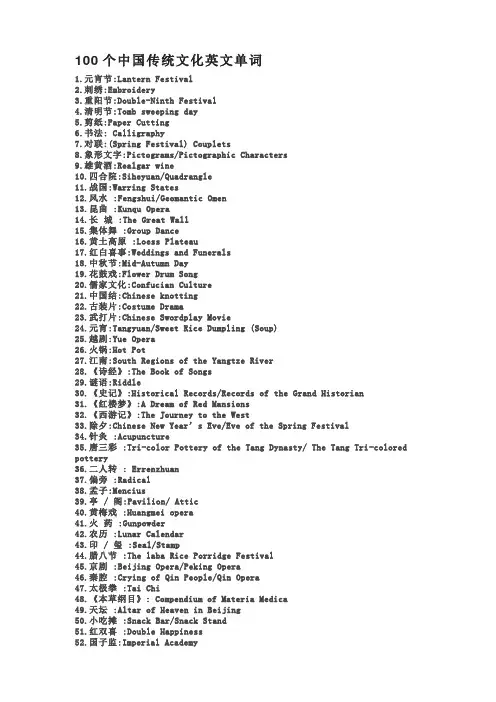
100个中国传统文化英文单词1.元宵节:Lantern Festival2.刺绣:Embroidery3.重阳节:Double-Ninth Festival4.清明节:Tomb sweeping day5.剪纸:Paper Cutting6.书法: Calligraphy7.对联:(Spring Festival) Couplets8.象形文字:Pictograms/Pictographic Characters9.雄黄酒:Realgar wine10.四合院:Siheyuan/Quadrangle11.战国:Warring States12.风水 :Fengshui/Geomantic Omen13.昆曲 :Kunqu Opera14.长城 :The Great Wall15.集体舞 :Group Dance16.黄土高原 :Loess Plateau17.红白喜事:Weddings and Funerals18.中秋节:Mid-Autumn Day19.花鼓戏:Flower Drum Song20.儒家文化:Confucian Culture21.中国结:Chinese knotting22.古装片:Costume Drama23.武打片:Chinese Swordplay Movie24.元宵:Tangyuan/Sweet Rice Dumpling (Soup)25.越剧:Yue Opera26.火锅:Hot Pot27.江南:South Regions of the Yangtze River28.《诗经》:The Book of Songs29.谜语:Riddle30.《史记》:Historical Records/Records of the Grand Historian31.《红楼梦》:A Dream of Red Mansions32.《西游记》:The Journey to the West33.除夕:Chinese New Year’s Eve/Eve of the Spring Festival34.针灸 :Acupuncture35.唐三彩 :Tri-color Pottery of the Tang Dynasty/ The Tang Tri-colored pottery36.二人转 : Errenzhuan37.偏旁 :Radical38.孟子:Mencius39.亭 / 阁:Pavilion/ Attic40.黄梅戏 :Huangmei opera41.火药 :Gunpowder42.农历 :Lunar Calendar43.印 / 玺 :Seal/Stamp44.腊八节 :The laba Rice Porridge Festival45.京剧 :Beijing Opera/Peking Opera46.秦腔 :Crying of Qin People/Qin Opera47.太极拳 :Tai Chi48.《本草纲目》: Compendium of Materia Medica49.天坛 :Altar of Heaven in Beijing50.小吃摊 :Snack Bar/Snack Stand51.红双喜 :Double Happiness52.国子监:Imperial Academy53.春卷 :Spring Roll(s)54.莲藕 :Lotus Root55.罗盘 :Luopan56.故宫博物院 :The Palace Museum57.相声:Cross-talk/Comic Dialogue58.五行 :Five Phases59.北京烤鸭 : Beijing Roast Duck60.《桃花扇》:The Peach Blossom Fan61.木偶戏:Puppet Show62.敦煌莫高窟:Mogao Caves63.电视小品:TV Sketch/TV Skit64.甲骨文:Oracle Bone Inscriptions65.古筝:Chinese Zither66.二胡 :Urheen67.门当户对:Perfect Match/Exact Match68.《水浒》: Water Margin/Outlaws of the Marsh69.端午节:Dragon Boat Festival70.文房四宝:“The Four Treasure of the Study” “Brush, Inkstick, Paper and Inkstone”71.兵马俑: Cotta Warriors/ Terracotta Army72.旗袍:Cheongsam73.指南针:Compass74.泼水节:Water-Splashing Day75.馄饨:Wonton76. 花卷:Steamed twisted rolls77.羊肉泡馍:Pita Bread Soaked in Lamb Soup78.冰糖葫芦:A stick of sugar-coated haws (or apples, etc.)79.八宝饭:Eight-treasure rice pudding80.粉丝:Glass Noodles81.豆腐脑:Jellied bean curd82.小品:Witty Skits83.孝顺:To show filial obedience84.武术:Wushu (Chinese Martial Arts)85.宣纸:Rice Paper86.衙门: Yamen87.叩头:Kowtow88.中庸:The way of medium(cf. Golden Means)89.牌楼:Pailou (pai-loo)90.东坡肉:Dongpo Pork91.中山陵:The Sun Yat-sen Mausoleum92.秦淮河:Qinhuai River93.玄武湖:Xuanwu Lake94.夫子庙:The Confucian Temple95.鸭血粉丝:Duck blood and Vermicelli Soup96.盐水鸭:Yanshuiya, or salted and baked duck97.大煮干丝:Gansi98.小笼包:Steamed buns99.明孝陵:Ming Tomb100.云锦:Nanjing brocade。
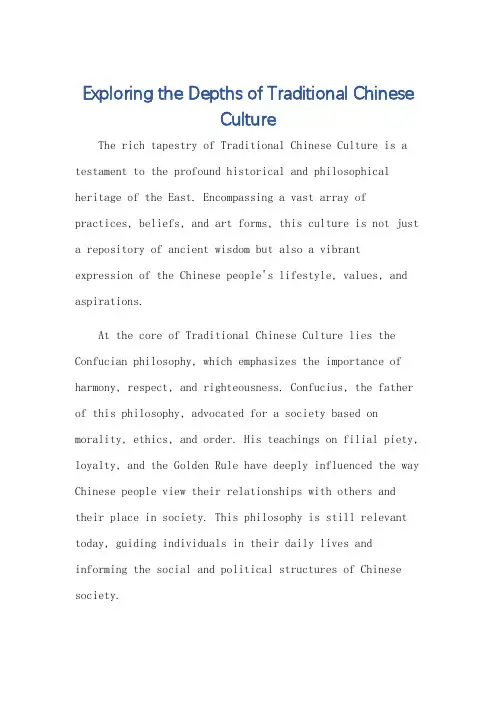
Exploring the Depths of Traditional ChineseCultureThe rich tapestry of Traditional Chinese Culture is a testament to the profound historical and philosophical heritage of the East. Encompassing a vast array of practices, beliefs, and art forms, this culture is not just a repository of ancient wisdom but also a vibrant expression of the Chinese people's lifestyle, values, and aspirations.At the core of Traditional Chinese Culture lies the Confucian philosophy, which emphasizes the importance of harmony, respect, and righteousness. Confucius, the father of this philosophy, advocated for a society based on morality, ethics, and order. His teachings on filial piety, loyalty, and the Golden Rule have deeply influenced the way Chinese people view their relationships with others and their place in society. This philosophy is still relevant today, guiding individuals in their daily lives and informing the social and political structures of Chinese society.Another important aspect of Traditional Chinese Culture is its rich artistic heritage. Chinese art, whether it be painting, calligraphy, pottery, or architecture, is renowned for its elegance, simplicity, and profound symbolism. The use of natural elements like water, stones, and flowers as motifs in art represents the Chineseaffinity with nature and their belief in the harmony of man with his surroundings. Calligraphy, in particular, is considered an extension of one's character and personality, with each stroke carrying deep meaning and emotional value. Music and dance are also integral to Chinese culture. Traditional Chinese instruments like the guqin, pipa, and drums create melodies that are both soothing and uplifting. These instruments, along with traditional dance forms like the dragon dance and lion dance, are often performed during festivals and special occasions, reflecting the joy and vitality of the Chinese people.The Chinese calendar is also a unique aspect of this culture, with each month, day, and season associated with specific meanings and celebrations. The Chinese New Year, for instance, is a time for family reunions, giving redenvelopes, and setting off fireworks to驱逐邪恶和迎来好运. These practices are deeply rooted in Chinese history and tradition, serving as a reminder of their cultural identity and heritage.In conclusion, Traditional Chinese Culture is a vast and diverse field that encompasses various aspects of life, from philosophy and art to music, dance, and festivals. This culture, with its unique blend of ancient wisdom and modern vitality, continues to inspire and influence people around the world, making it an integral part of global cultural heritage.**探寻中国传统文化的深厚底蕴**中国传统文化是一幅丰富多彩的织锦,见证了东方古老历史和哲学遗产的深厚底蕴。
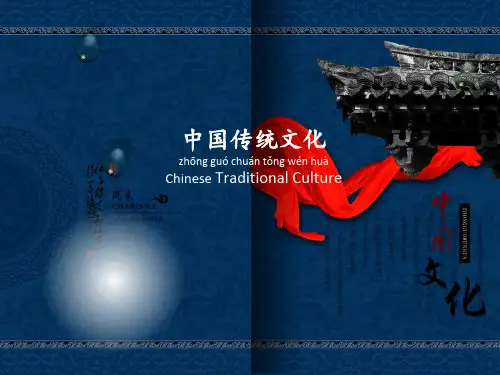
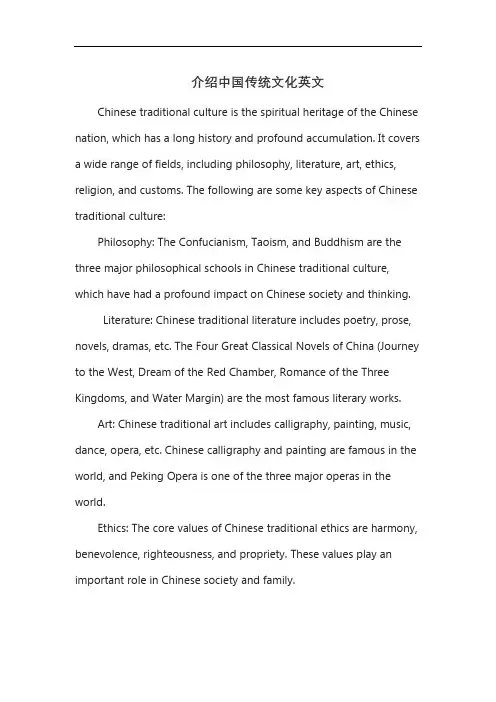
介绍中国传统文化英文Chinese traditional culture is the spiritual heritage of the Chinese nation, which has a long history and profound accumulation. It covers a wide range of fields, including philosophy, literature, art, ethics, religion, and customs. The following are some key aspects of Chinese traditional culture:Philosophy: The Confucianism, Taoism, and Buddhism are the three major philosophical schools in Chinese traditional culture, which have had a profound impact on Chinese society and thinking.Literature: Chinese traditional literature includes poetry, prose, novels, dramas, etc. The Four Great Classical Novels of China (Journey to the West, Dream of the Red Chamber, Romance of the Three Kingdoms, and Water Margin) are the most famous literary works.Art: Chinese traditional art includes calligraphy, painting, music, dance, opera, etc. Chinese calligraphy and painting are famous in the world, and Peking Opera is one of the three major operas in the world.Ethics: The core values of Chinese traditional ethics are harmony, benevolence, righteousness, and propriety. These values play an important role in Chinese society and family.Religion: Chinese traditional religion includes Buddhism, Taoism, and Islam. These religions have had a profound impact on Chinese society and culture.Custom: Chinese traditional customs include Spring Festival, Mid-Autumn Festival, Dragon Boat Festival, etc. These customs reflect the cultural traditions and values of the Chinese nation.In short, Chinese traditional culture is a rich and diverse cultural system that has had a profound impact on Chinese society and the world. It is the spiritual pillar of the Chinese nation and an important part of world culture.。
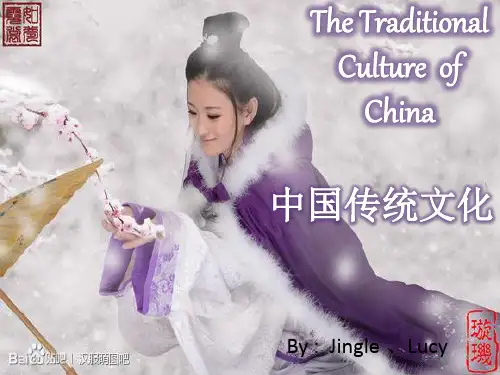
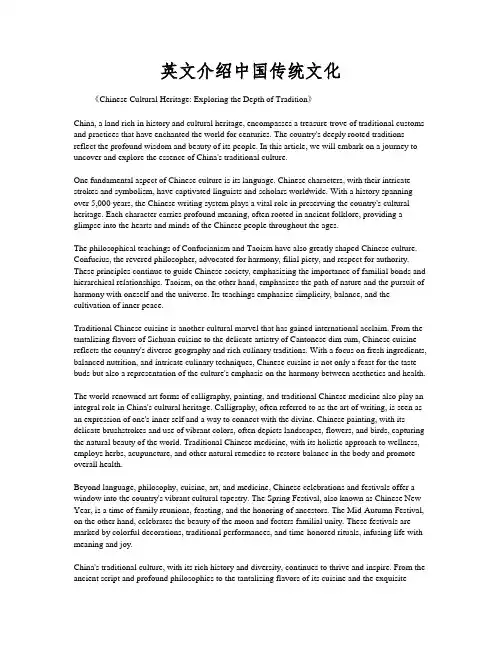
英文介绍中国传统文化《Chinese Cultural Heritage: Exploring the Depth of Tradition》China, a land rich in history and cultural heritage, encompasses a treasure trove of traditional customs and practices that have enchanted the world for centuries. The country's deeply rooted traditions reflect the profound wisdom and beauty of its people. In this article, we will embark on a journey to uncover and explore the essence of China's traditional culture.One fundamental aspect of Chinese culture is its language. Chinese characters, with their intricate strokes and symbolism, have captivated linguists and scholars worldwide. With a history spanning over 5,000 years, the Chinese writing system plays a vital role in preserving the country's cultural heritage. Each character carries profound meaning, often rooted in ancient folklore, providing a glimpse into the hearts and minds of the Chinese people throughout the ages.The philosophical teachings of Confucianism and Taoism have also greatly shaped Chinese culture. Confucius, the revered philosopher, advocated for harmony, filial piety, and respect for authority. These principles continue to guide Chinese society, emphasizing the importance of familial bonds and hierarchical relationships. Taoism, on the other hand, emphasizes the path of nature and the pursuit of harmony with oneself and the universe. Its teachings emphasize simplicity, balance, and the cultivation of inner peace.Traditional Chinese cuisine is another cultural marvel that has gained international acclaim. From the tantalizing flavors of Sichuan cuisine to the delicate artistry of Cantonese dim sum, Chinese cuisine reflects the country's diverse geography and rich culinary traditions. With a focus on fresh ingredients, balanced nutrition, and intricate culinary techniques, Chinese cuisine is not only a feast for the taste buds but also a representation of the culture's emphasis on the harmony between aesthetics and health.The world-renowned art forms of calligraphy, painting, and traditional Chinese medicine also play an integral role in China's cultural heritage. Calligraphy, often referred to as the art of writing, is seen as an expression of one's inner self and a way to connect with the divine. Chinese painting, with its delicate brushstrokes and use of vibrant colors, often depicts landscapes, flowers, and birds, capturing the natural beauty of the world. Traditional Chinese medicine, with its holistic approach to wellness, employs herbs, acupuncture, and other natural remedies to restore balance in the body and promote overall health.Beyond language, philosophy, cuisine, art, and medicine, Chinese celebrations and festivals offer a window into the country's vibrant cultural tapestry. The Spring Festival, also known as Chinese New Year, is a time of family reunions, feasting, and the honoring of ancestors. The Mid-Autumn Festival, on the other hand, celebrates the beauty of the moon and fosters familial unity. These festivals are marked by colorful decorations, traditional performances, and time-honored rituals, infusing life with meaning and joy.China's traditional culture, with its rich history and diversity, continues to thrive and inspire. From the ancient script and profound philosophies to the tantalizing flavors of its cuisine and the exquisitebrushstrokes on silk, Chinese traditions offer a glimpse into the soul of a nation deeply connected to its roots. As we explore the depths of Chinese culture, we are reminded of the timeless wisdom and enduring beauty that continues to shape our world.。
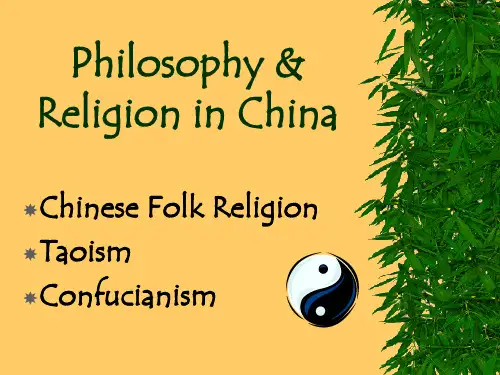
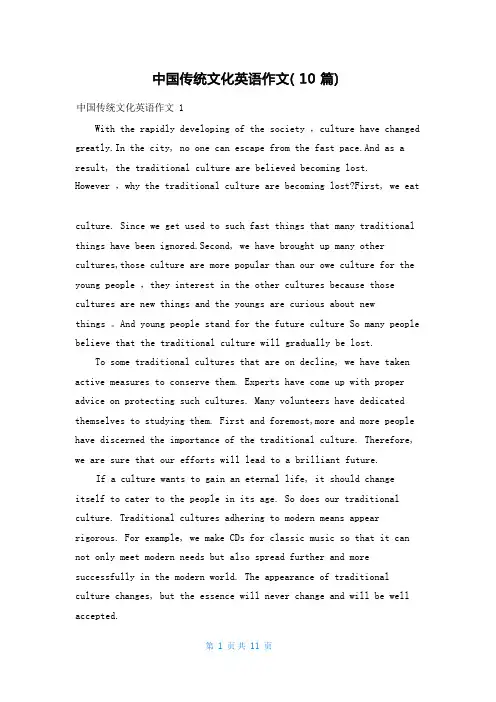
中国传统文化英语作文 1With the rapidly developing of the society ,culture have changed greatly.In the city, no one can escape from the fast pace.And as a result, the traditional culture are believed becoming lost.However ,why the traditional culture are becoming lost?First, we eatculture. Since we get used to such fast things that many traditional things have been ignored.Second, we have brought up many other cultures,those culture are more popular than our owe culture for the young people ,they interest in the other cultures because those cultures are new things and the youngs are curious about newthings 。
And young people stand for the future culture So many people believe that the traditional culture will gradually be lost.To some traditional cultures that are on decline, we have taken active measures to conserve them. Experts have come up with proper advice on protecting such cultures. Many volunteers have dedicated themselves to studying them. First and foremost,more and more people have discerned the importance of the traditional culture. Therefore, we are sure that our efforts will lead to a brilliant future.If a culture wants to gain an eternal life, it should change itself to cater to the people in its age. So does our traditional culture. Traditional cultures adhering to modern means appear rigorous. For example, we make CDs for classic music so that it can not only meet modern needs but also spread further and more successfully in the modern world. The appearance of traditional culture changes, but the essence will never change and will be well accepted.随着社会的快速发展,文化发生了巨大的变化。
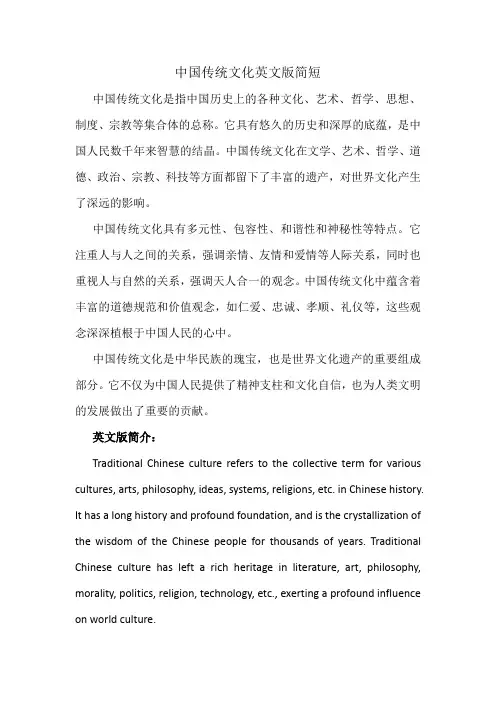
中国传统文化英文版简短中国传统文化是指中国历史上的各种文化、艺术、哲学、思想、制度、宗教等集合体的总称。
它具有悠久的历史和深厚的底蕴,是中国人民数千年来智慧的结晶。
中国传统文化在文学、艺术、哲学、道德、政治、宗教、科技等方面都留下了丰富的遗产,对世界文化产生了深远的影响。
中国传统文化具有多元性、包容性、和谐性和神秘性等特点。
它注重人与人之间的关系,强调亲情、友情和爱情等人际关系,同时也重视人与自然的关系,强调天人合一的观念。
中国传统文化中蕴含着丰富的道德规范和价值观念,如仁爱、忠诚、孝顺、礼仪等,这些观念深深植根于中国人民的心中。
中国传统文化是中华民族的瑰宝,也是世界文化遗产的重要组成部分。
它不仅为中国人民提供了精神支柱和文化自信,也为人类文明的发展做出了重要的贡献。
英文版简介:Traditional Chinese culture refers to the collective term for various cultures, arts, philosophy, ideas, systems, religions, etc. in Chinese history. It has a long history and profound foundation, and is the crystallization of the wisdom of the Chinese people for thousands of years. Traditional Chinese culture has left a rich heritage in literature, art, philosophy, morality, politics, religion, technology, etc., exerting a profound influence on world culture.Traditional Chinese culture has the characteristics of diversity, inclusivity, harmony, and mystery. It emphasizes the relationship between people, emphasizing interpersonal relationships such as family ties, friendship, and love, while also emphasizing the relationship between man and nature, emphasizing the concept of harmony between heaven and earth. Traditional Chinese culture contains a rich vocabulary of moral norms and values such as benevolence, loyalty, filial piety, and etiquette, which are deeply ingrained in the hearts of the Chinese people.Traditional Chinese culture is a national treasure of the Chinese nation and an important part of world cultural heritage. It not only provides a spiritual pillar and cultural confidence for the Chinese people, but also makes an important contribution to the development of human civilization.。
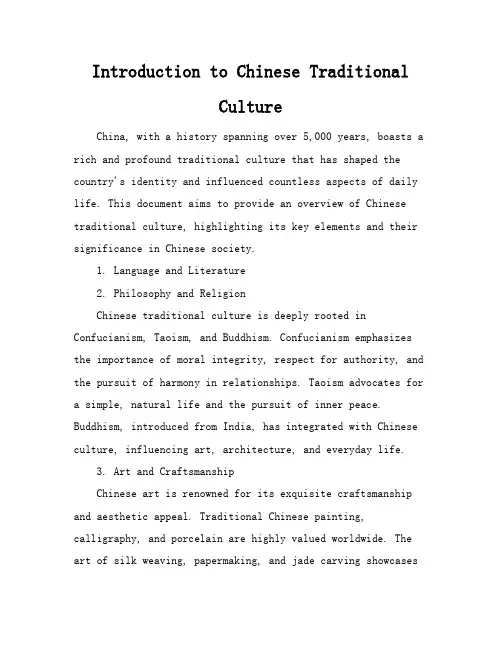
Introduction to Chinese TraditionalCultureChina, with a history spanning over 5,000 years, boasts a rich and profound traditional culture that has shaped the country's identity and influenced countless aspects of daily life. This document aims to provide an overview of Chinese traditional culture, highlighting its key elements and their significance in Chinese society.1. Language and Literature2. Philosophy and ReligionChinese traditional culture is deeply rooted in Confucianism, Taoism, and Buddhism. Confucianism emphasizes the importance of moral integrity, respect for authority, and the pursuit of harmony in relationships. Taoism advocates for a simple, natural life and the pursuit of inner peace. Buddhism, introduced from India, has integrated with Chinese culture, influencing art, architecture, and everyday life.3. Art and CraftsmanshipChinese art is renowned for its exquisite craftsmanship and aesthetic appeal. Traditional Chinese painting, calligraphy, and porcelain are highly valued worldwide. The art of silk weaving, papermaking, and jade carving showcasesthe ingenuity and skill of Chinese artisans. Moreover, the practice of Feng Shui, which aims to harmonize the flow of energy in a space, reflects the Chinese belief in the interconnectedness of nature and human life.4. Festivals and CustomsChinese festivals are a vibrant display of the country's cultural heritage. The Spring Festival (Chinese New Year) is the most important holiday, featuring traditional activities such as dragon and lion dances, fireworks, and family reunions. Other notable festivals include the Lantern Festival, Dragon Boat Festival, and MidAutumn Festival, each with its unique customs and traditions.5. Traditional ClothingThe Hanfu, a traditional Chinese attire, reflects the elegance and diversity of Chinese culture. Characterized its flowing lines and vibrant colors, Hanfu represents different social status, occasions, and historical periods. The Tang suit and Qipao are also iconic examples of Chinesetraditional clothing, showcasing the beauty and grace of Chinese women.In conclusion, Chinese traditional culture is a treasure trove of wisdom, art, and values that continue to shape the lives of people in China and around the world. By exploringthese cultural elements, we can gain a deeper understandingof the Chinese perspective on life, nature, and humanity.6. Culinary DelightsChinese cuisine is a vital part of its traditional culture, renowned for its diversity and emphasis on harmonyin flavors and ingredients. The practice of using a pair of chopsticks is not only a dining custom but also a reflectionof Chinese philosophy. Signature dishes such as Peking duck, hot pot, dim sum, and Sichuan spicy tofu (Mapo tofu)represent the rich tapestry of regional cuisines within China. The art of tea making and tea ceremonies further illustratethe Chinese pursuit of balance and tranquility in daily life.7. Architecture and GardensChinese architecture is characterized its use of wood, intricate carvings, and upturned eaves. The Forbidden City in Beijing and the classical gardens of Suzhou are prime examples of Chinese architectural excellence. Thesestructures are not only beautiful but also embody theprinciples of Feng Shui and the concept of harmony between humanity and nature. The gardens, in particular, are designed to mimic natural landscapes, providing a serene environmentfor contemplation and relaxation.8. Music and DanceChinese traditional music, with its unique scales and instruments such as the guzheng (zither), erhu (fiddle), and pipa (lute), creates a distinctive sound that is both soothing and evocative. Chinese classical dance, often performed in colorful costumes with flowing movements, tells stories and expresses emotions, drawing from historical legends and folk tales. The Peking Opera, with its elaborate costumes, makeup, and singing styles, is a famous form of traditional Chinese performing art.9. Martial Arts10. Social EtiquetteChinese society places a strong emphasis on respect, modesty, and humility. The concept of "face" (mianzi) is crucial in social interactions, representing one's reputation and social standing. Traditional greetings, such as bowing or clasping hands, and the exchange of business cards with both hands, demonstrate the importance of etiquette in Chinese culture. The practice of giftgiving, with its specific customs and taboos, is also a reflection of the respect and consideration shown in relationships.In exploring the depths of Chinese traditional culture, one cannot help but be inspired its richness and the enduring legacy it has left on the world. It is a culturethat invites us to look inward, to appreciate the beauty in simplicity, and to find harmony in the world around us.11. Folklore and MythologyChinese folklore and mythology are a tapestry of stories and legends that have been passed down through generations. These tales often feature mythical creatures like the dragon, phoenix, and qilin, which symbolize power, prosperity, and good fortune. Stories such as "Journey to the West," "Water Margin," and "The Investiture of the Gods" are not only literary masterpieces but also reflect the moral values and cultural norms of ancient China. These myths and legends continue to influence modern Chinese literature, film, and popular culture.12. Traditional Medicine13. Family ValuesFamily is the cornerstone of Chinese society, and traditional values place a strong emphasis on filial piety and ancestor worship. Elders are respected for their wisdom and experience, and the concept of "family" extends beyond the nuclear unit to include extended relatives. The family name (surname) is a source of pride and identity, often passed down through generations with a sense of duty to honor one's ancestors. The importance of family is reflected in thecelebration of festivals, where family reunions are a central tradition.14. Education and the Art of LearningEducation has always been highly valued in Chinese culture, with a focus on the pursuit of knowledge and the cultivation of moral character. The ancient Chinese education system emphasized the Four Arts: qin (a string instrument), shu (calligraphy), hua (painting), and qi (the game of Go). Today, the Chinese education system continues to be rigorous, with a strong emphasis on academic achievement and the Confucian values of respect for teachers and the importance of learning.15. Ceremonies and RitualsChinese culture is rich with ceremonies and rituals that mark life's milestones, such as births, weddings, and funerals. These events are often steeped in tradition, with specific customs and rituals that have been followed for centuries. For instance, Chinese weddings are filled with symbolic gestures, such as the exchange of red envelopes (hongbao), the tea ceremony, and the wearing of traditional attire. These rituals are not only celebratory but also serve to reinforce cultural identity and continuity.In conclusion, the depth and breadth of Chinesetraditional culture are truly aweinspiring. It is a livingheritage that continues to evolve while maintaining its roots in ancient wisdom. By understanding and appreciating these cultural elements, we gain insight into the soul of a civilization that has shaped and continues to shape the world in countless ways.。
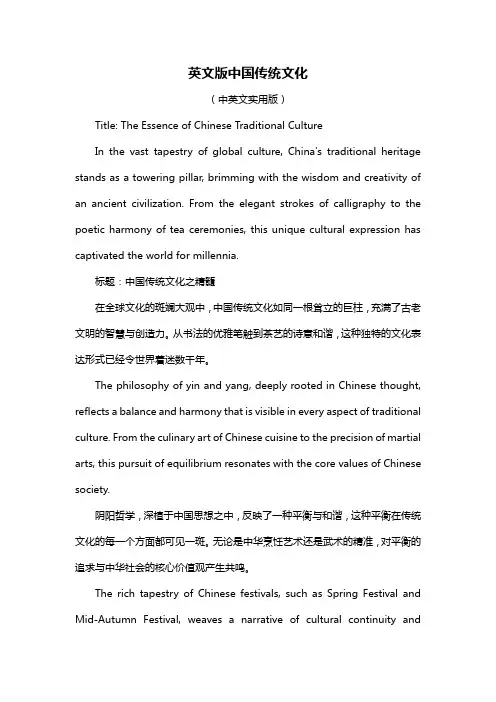
英文版中国传统文化(中英文实用版)Title: The Essence of Chinese Traditional CultureIn the vast tapestry of global culture, China's traditional heritage stands as a towering pillar, brimming with the wisdom and creativity of an ancient civilization. From the elegant strokes of calligraphy to the poetic harmony of tea ceremonies, this unique cultural expression has captivated the world for millennia.标题:中国传统文化之精髓在全球文化的斑斓大观中,中国传统文化如同一根耸立的巨柱,充满了古老文明的智慧与创造力。
从书法的优雅笔触到茶艺的诗意和谐,这种独特的文化表达形式已经令世界着迷数千年。
The philosophy of yin and yang, deeply rooted in Chinese thought, reflects a balance and harmony that is visible in every aspect of traditional culture. From the culinary art of Chinese cuisine to the precision of martial arts, this pursuit of equilibrium resonates with the core values of Chinese society.阴阳哲学,深植于中国思想之中,反映了一种平衡与和谐,这种平衡在传统文化的每一个方面都可见一斑。
英文中国传统文化作文模板英文,Chinese traditional culture is a rich and diverse heritage that has been passed down through generations. It encompasses a wide range of practices, beliefs, customs, and values that have shaped the way of life for the Chinese people. From ancient philosophies such as Confucianism and Taoism to traditional Chinese medicine and martial arts, Chinese culture is deeply rooted in history and has had a profound influence on the world.One of the most important aspects of Chinesetraditional culture is the value placed on family andfilial piety. In Chinese culture, family is the cornerstone of society, and respecting and honoring one's parents and ancestors is of utmost importance. For example, during the Chinese New Year, families come together to celebrate and pay respects to their elders, and it is a time for reconciliation and strengthening family bonds. This emphasis on family has helped to maintain a strong sense of unity and cohesion within Chinese communities.Another significant aspect of Chinese traditionalculture is the practice of traditional Chinese medicine (TCM). TCM has been used for thousands of years to treatand prevent illness, and it is based on the concept of balancing the body's energy, or qi. Acupuncture, herbal medicine, and qigong are all integral parts of TCM, andthey continue to be widely practiced in China and aroundthe world. For example, when I was younger, my grandmother would always brew herbal teas for us whenever we felt unwell, and she would use acupuncture to relieve any aches and pains. These experiences have instilled in me a deep appreciation for the holistic approach of TCM.中文,中国传统文化是一个丰富多彩的遗产,通过几代人的传承而延续至今。
传播中国传统文化英语作文5篇第一篇: 传播中国传统文化英语作文 Speaking of Chinese traditional culture that there are, however, and let all I remember is the Spring Festival.The Spring Festival is the most ceremonious traditional festival of the Chinese people, is a symbol of unity, prosperity, and on the new hope for the future of festival, how to celebrate this holiday, in one thousand years of history development, formed some relatively fixed customs and habits, there are a lot of handed down also. One of the custom is to eat dumplings. Before eat dumplings, of course, want to make dumplings. I to eat the delicious dumplings, then move to fit yourself.Want to eat dumplings will make dumplings, the dumplings is not easy to do. And first before making dumplings. I poured some noodles in the bowl, took bowl poured some water in it. First water less, knead out surface picked it up and down off the surface of slag. Added some water, surface and stick in my hand. Ah, always add water is not appropriate, the light and so hard for you, wait to eat dumplings will have to wait until what time! Added a little dry flour, finally done. But a listen to mama said still have half an hour, really, I"m impatient. Surface well, rushed to the side, I can"t wait to come up with a small piece of surface to mother make dumplings before action to face knead into a slender bar. Knead the results section of thick section thin ok rub it for a long time and finally kneaded. I suddenly thought: since dumplings as stuck in the traditional Chinese culture, it must be very delicious dumplings, butmust have certain difficulty. In order to eat the delicious dumplings! Then began to cut the surface into small pieces, and then continue to roll. And the top priority, rolling skin is the most difficult thing. If the thin skin dumplings easy broken, if the skin thick dumpling stuffing cooked skin not cooked. I put a small piece of a small piece of face became a cute little persimmon according to size, and ready to roll leather. I in one hand and a small cake, in one hand and a rolling pin to roll the wrappers. Ah, like mother rolling skin good hard ah, I really can"t learn in the end I like rolling pie rolling the wrappers. Although methods clumsy but the effect is good. The pack dumpling, mom gave me a my favorite pork green Chinese onion stuffing. I picked up the roll good skin beside the mother to make dumplings. Pack out after a dumplings, dumplings suddenly feel is not so difficult. Finally wrapped began to cook, I beside the pot forward to the dumplings boiled. Looked at the dumplings in the churning like pieces of white fish in the joy of the game. Dumplings are cooked! His mouth to eat dumplings the in the mind say a happy. Instantly, I think I"m close to China"s traditional culture also step.第二篇: 传播中国传统文化英语作文 Protecting traditional Chinese culture is of great importance to China"s cultural diversity, economic prosperity, and social development. The government in Guangdong province has made it their mission to protect Chaoju , a local form of drama that began in Chaozhou in eastern Guangdong.In my opinion, specific measures should be taken to protect traditional Chinese culture. To start with, we should make appropriate laws for everyone to follow. Also, we should educate people about the need to protect traditional culture. The more thepublic knows about it, the more support we can get.It"s time that we start treasuring our own valuable culture.第三篇: 传播中国传统文化英语作文 The passage mainly tells us the importance of protecting traditional Chinese culture, which is challenged or facing extinction because of the developing society and changing lifestyle. Besides, China is nationwide sparing no efforts to do it.The protection of national and folk culture is of greatsignificance to Chinese cultural diversity and also to the harmonious development between local economic and social development. It is reported that the Guangdong government pays special attention to protecting Chaoju, a local drama born in Chaozhou in the eastern Guangdong province.In my opinion, some measures should be taken to protect traditional culture effectively. To start with, we should make a law to regulate the society"s performance. Besides, we should draw more people"s attention to it, for the more they know about the importance of culture protection, the stronger the support we can get from the public.In a word, it is high time for us to treasure and develop our own valuable culture.China has the history of more than 5,000 years and we are so proud of the profound culture. Every year, we are so looking forward to spending the holiday during the traditional festivals. They are the important part of Chinese traditional culture. But for young people, the meaning of these festival is fading away.When young people are asked about the meaning of traditional festival, some of them have no idea. For example, some young peoplebelieve that Mid-autumn Festival is to in honor of the ancestors, or it is a day to eat mooncake. Actually, most festivals have been advocated by the commercial ads, and they show people to buy more products to spend the festivals happily. Some ads try to implant people the wrong idea about the meaning of festival, just to attract more customers.The loss meaning of traditional festivals brings the negative side to the preserve of traditional culture. The mass media should advocate the essence of the festivals, so as to let the young generation learn more about our culture and be proud of it.第四篇: 传播中国传统文化英语作文 Traditional Chinese culture is beginning to capture the attention of the world. This is true even as popular culture that has traditionally been considered Western begins to spread throughout China.Kung Fu, especially, has had a great impact on the millions of people who first learned about China through it. From that, they may come to China and learn about other aspects of this culture, such as traditional operas like the Beijing and Sichuan ones.Asian nations have long known about the greatness of ancient Chinese culture.Their own cultures are a mix of native ones and those Chinese characteristics.Korea and Japan long ago adopted ideas such as Confucianism is something that continues today even as it is challenged by Pop Culture.This strength comes from the ideas given in the Four Books of Confucianism (The Great Learning, The Doctrine of the Mean, The Analects of Confucius, and The Book of Mencius). These books builtupon the ideas of an even more ancient period codified in the Five Classics.From them, the West learns such things as Fengshui and other concepts that are uniquely Chinese. China has taken steps to further this spread of its culture by establishing Chinese Cultural Centersin such places as the United States and Europe.第五篇: 传播中国传统文化英语作文 With the rapidly developing of the society ,culture have changed greatly.In the city, no one can escape from the fast pace.And as a result, the traditional culture are believed becoming lost. However ,why the traditional culture are becoming lostFirst, we eat the popularized fast food and enjoy the popularized "fast food" culture. Since we get used to such fast things that many traditional things have been ignored.Second, we have brought up many other cultures,those culture are more popular than our owe culture for the young people ,they interest in the other cultures because those cultures are new things and the youngs are curious about new things .And young people stand for the future culture So many people believe that the traditional culture will gradually be lost.To some traditional cultures that are on decline, we have taken active measures to conserve them. Experts have come up with proper advice on protecting such cultures. Many volunteers have dedicated themselves to studying them. First and foremost,more and more people have discerned the importance of the traditional culture. Therefore, we are sure that our efforts will lead to a brilliant future.If a culture wants to gain an eternal life, it should change itself to cater to the people in its age. So does our traditional culture. Traditional cultures adhering to modern means appear rigorous. Forexample, we make CDs for classic music so that it can not only meet modern needs but also spread further and more successfully in the modern world. The appearance of traditional culture changes, but the essence will never change and will be well accepted.传播中国传统文化英语作文。
1、元宵节Lantern Festival2、刺绣Embroidery3、重阳节Double-Ninth Festival4、剪纸Paper Cutting5、书法Calligraphy6、清明节Tomb-sweeping Day7、对联(春联) (Spring Festival)Couplers8、象形文字Pictograms/PictographicCharacters9、雄黄酒Realgar wine10、四合院Siheyuan/Quadrangle11、战国Warring States12、风水Fengshui/Geomantic Omen13、昆曲Kunqu Opera14、长城The Great Wall15、集体舞Group Dance16、黄土高原Loess Plateau17、红白喜事Weddings and Funerals18、中秋节Mid-Autumn Festival19、花鼓戏Flower Drum Song20、儒家文化Confucian Culture21、中国结Chinese knotting22、古装片Costume Drama23、武打片Chinese Swordplay Movie24、元宵Tangyuan/Sweet Rice Dumpling (Soup)25、越剧Yue Opera26、火锅Hot Pot27、江南South Regions of theYangtze River28、《诗经》The Book of Songs29、谜语riddle30、《史记》Historical Records/Records of the Grand Historian31、《红楼梦》 A Dream of Red Mansions32、《西游记》The Journey to theWest33、除夕Chinese New Year’sEve/Eve of the Spring Festival34、针灸Acupuncture35、唐三彩Tri-color Pottery of theTangDynasty/The Tang Tri-colored pottery36、二人转Errenzhuan37、偏旁Radical38、孟子Mencius39、亭/阁Pavilion/Attic40、黄梅戏Huangmei Opera41、火药Gunpowder42、农历Lunar Calendar43、印/玺Seal/Stamp44、腊八节The laba Rice PorridgeFestival45、京腔Beijing Opera/PekingOpera46、秦腔Crying of Qin People/Qin Opera47、太极拳Tai Chi48、《本草纲目》Compendium of MateriaMedica49、天坛Altar of Heaven inBeijing50、小吃摊Snack Bar/Snack Stand51、红双喜Double Happiness52、国子监Imperial Academy53、春卷Spring Roll(s)54、莲藕Lotus Root55、罗盘Luopan56、故宫博物院The Palace Museum57、相声Cross-talk/Comic Dialogue58、五行Five Phases59、北京烤鸭Beijing Roast Duck60、《桃花扇》The Peach Blossom Fan61、木偶戏Puppet Show62、敦煌莫高窟Mogao Caves63、电视小品TV Sketch/TV Skit64、甲骨文Oracle BoneInscriptions65、古筝Chinese Zither66、二胡Urheen67、门当户对Perfect Match/Exact Match68、《水浒》Water Margin/Outlaws of the Marsh69、文房四宝(笔墨纸砚)The Four Treasure oftheStudy (Brush, Inkstick,Paper and Inkstone)70、兵马俑Cotta Warriors/Terracotta Army71、旗袍Cheongsam72、指南针Compass73、泼水节Water-Splashing Day74、馄饨Wonton75、花卷Steamed twisted rolls76、羊肉泡馍Pita Bread Soaked in Lamb Soup77、冰糖葫芦 A stick of sugar-coated haws (or apples, etc.)78、八宝饭Eight-treasure rice pudding79、粉丝Glass Noodles80、豆腐脑Jellied bean curd81、小品Witty Skits82、孝顺To show filial obedience83、武术Wushu(Chinese Martial Arts84、宣纸Rice Paper85、衙门Yamen86、叩头Kowtow87、中庸The way of medium88、牌楼Pailou(pai-loo)89、东坡肉Dongpo Pork90、中山陵The Sun Yat-sen Mausoleum91、秦淮河Qinhuai River92、玄武湖Xuanwu Lake93、夫子庙The Confucian Temple94、鸭血粉丝Duck blood fans95、盐水鸭Yanshuiya/salted and baked duck96、大煮干丝Gansi97、小笼包Steamed buns98、明孝陵Ming Tomb99、云锦Nanjing brocade100、虾饺shrimp dumplings101、叉烧包Steamed BBQ Pork Bun102、蛋挞custard tart103、干蒸烧卖Steamed Dumplings104、肠粉Steamed Rice Rolls105、马蹄糕Horseshoe cake106、干炒牛河Stir-Fried Rice Noodles with Beef。
关于中国文化,特别是传统文化中的一些热门元素,作为国人的我们,肯定是要比外国人要更清楚,掌握得更好一些。
从实际的角度来说,各种考试,比赛,辩论,写作,肯定是避不了了。
与其被动考试,不如主动出击:100个中国传统文化英文词汇,常见的节假日、中国美食、各种古典文学、名胜古迹等等100个中国传统文化英文词汇,转走学起~1.腊八节The Laba Rice Porridge Festival/Laba Festival2.除夕New Year s Eve3.春节The Spring Festival4.元膏节Lantern Festival5.清明节Qingming Festival/Tomb-Sweeping Day6.端午节Dragon Boat Festival7.七夕节Double Seventh Festival8.中秋节Mid-Autumn Festival9.重阳节Double Ninth Festival10.春联Spring Festival couplets11.拜年Paying a New Year call12.北京烤鸭Beijing roast duck13.豆藂Soybean milk14.馒头Mantou/steamed bun15.火锅Hot pot16.春卷Spring roll17.炸酱面Noodles with soybean paste18.麻花Fried dough twist19.粽子Zongzi/rice dumpling20.拉面Hand-pulled noodles/stretched noodles21.馄饨Wonton/chinese dumplingsoup22.豆腐Tofu/bean curd其它传统美食:年糕:Rice cake;New Year cake饺子:Dumplings;jiaozi汤圆:Dumplings made of sweet rice春卷:Spring roll八宝饭:Eight-treasure rice pudding (steamed glutinous rice with bean paste, lotus seeds, preserved fruit, etc.) 花生糖:Peanut candy瓜子:Red melon seeds红枣:Red dates冰糖葫芦:Candied haws on a stick腊肠:Chinese sausage腊肉:Preserved meat糖炒栗子:Sugar chestnut23.《史记》The Historical Records24.《诗经》The Book of Songs25.《春秋》The SSpring and Autumn Annals26.《论语》The Analects of Confucius27.《三国演义》Romance of the Three Kingdoms28.《术游传》Water Margin/Outlaws of the Marsh29.《西游记》Pilgrimage to the West/丁oumey to the West30.《红楼梦》A Dream in Red Mansions/The Story of the Stone31.《山海经》The Classic of Mountains and Rivers32.《三字经》Three-Character Scripture33.《资治通鉴》History as a Mirror34.长城The Great Wall35.泰始皇陵Mausoleum of the First Qin Emperor36.兵马偏Terra-Cotta Warriors37.敦煌莫高Mo Kao Grotto at Dunhuang38.敲楼Drum-tower39.故宫The Forbidden City/the Palace Museum40.天坛Temple of Heaven41.西湖West Lake42.日月潭Sun Moon Lake/Riyuetan Pool43.十三陵The Ming Tombs44.苏州园林Suzhou Garden(s)45.四大发明The four great inventionsof ancient China46.火药Gunpowder47.印刷术Printing/arts of printing48.造纸术Papermaking technology49.指南针Compass50.中国结Chinese knot51.青钥器Bronzeware52.瓷器china/porcelain53.刺绣Embroidery54.中药TCM/traditional chinese medicine55.四合院Courtyard56.京剧Peking opera57.皮影戏Shadow play58.太极Tai Chi59.对口相声Cross talk60.杂技Acrobatics/acrobatic performance61.中国武术Chinese martial arts/Kung Fu62.越剧Yue opera63.唐装Tang suit64.旗抱Cheongsam65.古筝Chinese zither66.二胡Erhu其它曲艺表演:戏曲:Traditional opera折子戏:Opera highlights相声:Comic dialogue;cross talk小品:Skits;sketch口技:Vocal imitations;ventriloquism 马戏:Circus performance京韵大鼓:Drum song of Peking踩高跷:Walk on stilts杂耍:Cariety show;vaudeville其它民间艺术:泥人:Clay figure木偶戏:Puppet show刺绣:Embroidery剪纸:Paper-cut中国结:Chinese knot年画:New Year painting吹糖人:Sugar-figure blowing舞龙:Dragon dance舞狮:Lion dance秧歌:Yongko dance;rural folk dance灯笼:Lantern67.甲骨文Oracle bone script68.世慈制度Hereditary system69.朝代Dynasty70.战国时期The Warring States Period71.三国The Three Kingdoms72.泰始皇The First Emperor of Qin73.皇太后Empress Dowager74.士大夫Scholar-officials/Literati and officialdom75.诸侯Vassal76.宰相Prime minister in feudal China77.西域The Western Regions各路神仙门神:The God of Door灶神:The God of Kitchen财神:The God of Wealth土地爷:The God of Land火神:The God of Fire喜神:The God of Happiness福禄寿三星:The three gods of fortune, prosperity and longevity八仙:The Eight Immortals78.武侠小说Martial arts novel79.八股文The eight-part essay/stereotyped writing80.五言绝句Five-character quatrains81.七言律诗Seven-character octave82.朦胧诗Misty poetry83.诗人Poet84.六艺The classic six arts85.民间艺术Folk art86.中国文学Chinese literature87.中国书法Chinese calligraphy88.古装片Costume flim89.国画Chinese painting90.儒学Confucianism91.孔子Confucius92.孟千Mencius93.法家Legalism94.墨家Mohism95.孝顺Filial96.中庸Doctrine of golden mean97.神话Mythology98.玉皇大帝The Jade Emperor99.美猴王Handsome Monkey King100.中千佳人Gifted scholars andbeautiful ladies 传统娱乐活动:打麻将:Play mahjong庙会:Temple fair春节联欢晚会:Spring Festival Gala Evening 灯会:Exhibit of lanterns送贺卡:Send New Year's greeting cards理发:Have a haircut放烟花:Set off fireworks放鞭炮:Set off firecrackers灯谜:Riddles written on lanterns。
1. According to the Constitution of the People’s Republic of China, what are the administrative divisions of China? 根据中华人民共和国宪法,我国的行政划分是什么? The country is divided into provinces, autonomous regions and municipalities directly under the central government. 我国的行政划分是省,自治区和直辖市。 2. What climatic zone does China lies in? China’s climate conditions vary greatly. It includes tropical, subtropical, the temperate and cool-temperate conditions. But the country for the most part lies in temperate zone. 中国的气候条件差异很大,包括热带,亚热带,温带和中温带。但是大多数区域处于温带。 3. In what area does China still fall behind its neighbors? 中国在什么领域落后于邻国? China still falls behind its neighbors in the area of design. 中国在设计领域落后于邻国。 4. How many schools is cooking in China divided into? 中式烹饪有那几派? Cooking in China is divided into four schools: the Cantonese, Sichuan, Shandong, and Huaiyang Dishes. 中式烹饪分为粤菜,川菜,鲁菜和淮阳菜。 5. What are the main condiments of Cantonese dishes? 粤菜的主要佐料是什么? The main condiments of the dishes are characteristically oyster sauce, fermented soy bean sauce, fish sauce, lard, sugar and vinegar. 粤菜主要佐料是具有鲜明特色的蚝油,酱油,鱼酱,猪油,糖和醋。 6. What are the characteristics of Cantonese dishes? 粤菜的特色是什么? Cantonese dishes are famous for their fresh materials and great tenderness. 粤菜以鲜嫩闻名。 7. Why do Sichuan dishes enjoy great popularity all over the country? 为什么川菜享誉全国? They enjoy the popularity because of their distinct and various flavors. Some of the most famous flavors are derived from fish flavors, pepper powder boiled in oil, strange flavor and sticky-hot. 川菜享誉全国是由于其独特而又多样的口味,包括鱼香味,辣椒油,怪味和麻辣。 8. What are the characteristics of Shandong dishes? 鲁菜的特色是什么? The Shandong cuisine is famous for its wide selection of materials, cooking methods, and seafood. 鲁菜以选料广泛,烹饪技法和海鲜闻名。 9. What are the cooking methods of Shandong dishes? 鲁菜的烹饪方法有哪些? The cooking techniques include BAO (quick frying), LIU (quick frying with corn flour), PA (stew braising) roasting and boiling, using sugar to make / clothe fruit, and crystallizing with honey. 烹饪方法包括爆,熘,扒,烤和水煮,用糖做水果的糖衣,用蜂蜜结晶。 10. What are the major categories of Chinese tea? 中国茶主要有哪几种? Tea from China includes black tea, jasmine tea, Wulong tea, green tea, and brick tea. 中国茶包括红茶,茉莉花茶,乌龙茶,绿茶和砖茶。 11. What is the benefit of drinking tea? 喝茶的好处 Drinking tea could quench thirst, overcome fatigue, help digestion and dilute fat. Tea is also rich in various vitamins. It could protect us from radiation and be used as an antiseptic. 喝茶可以止渴,消除疲劳,助消化,溶解脂肪。茶叶富含多种维生素,防辐射,也可以用来解毒。 12. What are the types of classical Chinese gardens? 中国古典园林有哪些类型? Classical Chinese gardens comprise imperial garden, private garden and temple garden. 中国古典园林包括皇家园林,私家园林和寺庙园林。 13. What are the elements in/inside Chinese gardens? 中国园林内部有哪些元素? In classical Chinese gardens, natural elements include flowers, grass, trees, rocks and ponds, while man-made or artificial elements comprise halls, verandas, waterside kiosks, pavilions and bridges. 古典中国园林中,自然元素包括花草树木,小山和池塘,人造元素包括亭台楼阁和小桥。 14. What is ancient Chinese architecture renowned for? 古代中国建筑因什么而著名? Ancient Chinese architecture is renowned for its unique structural system, graceful forms and rich artistic decorations. 古代中国建筑以独特的结构,优雅的造型和丰富的艺术装饰而闻名 15. What are the long-standing architectural ideas still practiced today? 至今任被沿用的建筑理念是什么? The use of symmetry and axes, and the orientation of buildings and structures towards the south are the long-standing architectural ideas still practiced today. 对称,中轴线,建筑物坐北朝南,这些建筑观点至今仍被沿用。 16. What is the post and lintel frame in ancient Chinese architecture? 中国古代建筑的柱檩结构是什么? The post and lintel frame is a structural system in which beams and columns, instead of walls, support the load. 柱檩结构是指用柱梁而非墙体承受重力的建筑结构。 17. What are the advantages of the post and lintel frame in ancient Chinese architecture? 柱檩结构的优点是什么? With the frame, the walls are not weight bearing, thus they can be set up according to space requirements,dividing the building,as desired. 有了这种结构,墙体不需要承重,因此,墙体可以根据空间要求而布局,随意分割建筑物。 Another advantage of the frame is its resistance to earthquake. 该结构的另一个优点是防震。 18. What does “the house will not collapse even if the walls give in” mean? “房屋不怕墙倒塌”是什么意思? With the post and lintel frame, the walls are not weight bearing, thus they can be set up according to space requirements,dividing the building,as desired. 有了这种结构,墙体不需要承重,因此,墙体可以根据空间要求而布局,随意分割建筑物。 Even if the walls fall, the house itself will not fall because it is the post and lintel that bear the weight. 即使墙体倒塌,房屋本身也不会倒塌,因为承重是柱檩,而不是墙体。 19. Please give an example to show the unity of utility and beauty in ancient Chinese architecture? 请举例说明中国古代建筑实用与美化的统一。 The coat of colored oil paint in the ancient Chinese architecture is a good example of the unity of utility and beauty. It is developed out of a need to protect the wood of the ancient Chinese architecture, but it is also very beautiful. 油彩画很好地说明了中国建筑实用与美化的统一。它是因为要保护建筑的木材而发展起来的,但它也非常美观。 20. What is Sushi’s philosophy represented in his lyrics? 反应在苏轼词里的哲学思想是什么? His philosophy is a combination of Confucianism and Taoism. To serve the Crown and to attain great renown is his Confucian ideal and to retire as times require and to be detached from